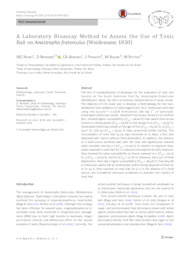A laboratory bioassay method to assess the use of Toxic bait on anastrepha fraterculus (Weidemann 1830).
A laboratory bioassay method to assess the use of Toxic bait on anastrepha fraterculus (Weidemann 1830).
Author(s): NUNES, M. Z.; BERNARDI, D.; BARONIO, C. A.; PASINATO, J.; BALDIN, M. M.; BOTTON, M.
Summary: The lack of standardization of bioassays for the evaluation of toxic baittoxicity on the South American fruit fly,Anastrepha fraterculus(Weidemann 1830), has led to erroneous interpretations of assay results.The objective of this study was to develop a methodology for the stan-dardization and validation of toxicological tests onA. fraterculustoxic baitusing the Success?0.02CB formulation (80 mg L−1of spinosad).Anastrepha fraterculusadults, obtained from larvae reared on an artificialdiet, showed higher susceptibility (LT50= 48.96 h) than adults from larvaereared on cattley guava (LT50= 53.83 h) and mango fruit (LT50= 53.55 h).Anastrepha fraterculusadults at the age of five (LT50= 65.30 h), 15 (LT50=59.01 h), and 30 (LT50= 55.53 h) days presented similar toxicity. Theconsumption of toxic bait (4.74 mg) increased at 15 days, a fact alsoobserved with insects without food deprivation. In addition, the absenceof a food source (artificial diet) with the toxic bait significantly reducedadult mortality time by 7 h (LT50= 57.42 h). In relation to exposure time,adults exposed to toxic bait for 1 h reduced consumption by 25%; however,they showed the same susceptibility as insects exposed to 2 (LT50=55.72h), 4 (LT50=57.64h),and8h(LT50= 57.76 h). However, with 24 h of fooddeprivation, they had a higher susceptibility (LT50= 46.48 h). Five-day-oldA. fraterculusadults fed an artificial diet before being deprived of food for12 or 24 h, then exposed to toxic bait for 4 h in the absence of a foodsource, are considered optimum conditions to evaluate the toxicity oftoxic bait.
Publication year: 2020
Types of publication: Journal article
Unit: Embrapa Grape & Wine
Keywords: Frui fly, Methodology, South American fruit fly, Spinosad
Observation
Some of Embrapa's publications are published as ePub files. To read them, use or download one of the following free software options to your computer or mobile device. Android: Google Play Books; IOS: iBooks; Windows and Linux: Calibre.
Access other publications
Access the Agricultural Research Database (BDPA) to consult Embrapa's full library collection and records.
Visit Embrapa Bookstore to purchase books and other publications sold by Embrapa.

